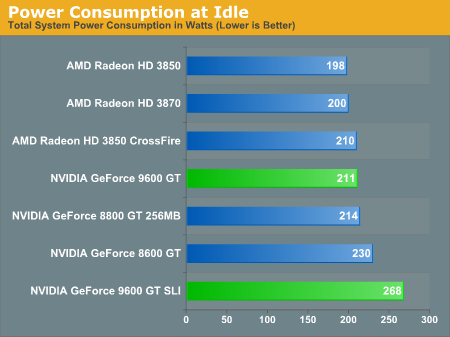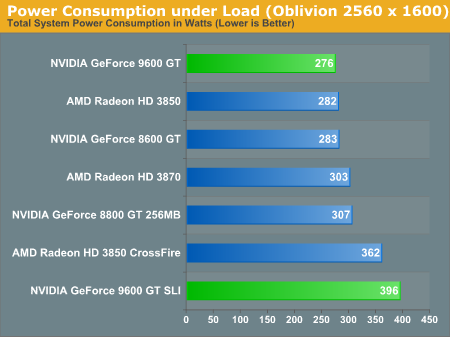Bringing Competition to Midrange: The GeForce 9600 GT Raises NVIDIA's Sub $200 Bar
by Derek Wilson on February 21, 2008 9:00 AM EST- Posted in
- GPUs
The Card and The Test
The Hardware
Palit provided us with a rather amazing little 9600 GT, but we received it a little later than our EVGA parts and we didn't have two of the Palit cards to test SLI either. We've done our testing here with the parts EVGA sent us, but there are some very interesting 9600 GT parts coming out.
The Palit part absolutely deserves a mention, and we will be testing it out as soon as we get a chance. Among the notable features is the fact that Palit has provided not only 2 dual-link DVI ports, but interfaces for both HDMI and DisplayPort. There is also an optical SPDIF input on the back enabling audio to be sent over HDMI.
But let's get back to the hardware at hand. NVIDIA reports that the GeForce 9600 GT will draw about 95W in real world apps. This means it does require a PCIe power connector to provide the added juice over the 75W available from the motherboard via the PCIe x16 slot.


The reference design used by EVGA is single slot and makes use of a fan shroud that covers the entire front face of the card. The Palit card we received is a two slot solution, but the main reason for this seems to be the inclusion of all the added I/O. The EVGA part isn't very loud, but we will be interested in comparing the noise levels between the reference design and Palit's larger solution to see if there is any real advantage from going with the wider model.
Our Test Setup
All of today's tests were performed on the 64-bit version of Windows Vista running on a monster of a system. We test all of our graphics cards on high end hardware in order to eliminate the bottlenecks associated with anything but graphics. This means it isn't likely that our numbers will reflect what our readers will see when actually playing a game, but what it does show is which video card is actually capable of providing a better experience when in a situation where graphics processing is the bottle neck.
Isolating the graphics subsystem is important for a few reasons. We can't know what is in your system and we haven't (yet) been able to test every graphics card with every CPU and system memory configuration out there. If you run a system slower than our test bed, you may run into CPU or system memory limited situations, in which case average frame rate won't be governed only by the GPU.
So why is graphics card selection still important? Because the graphics card has the most impact on graphics quality and performance of any single component in the system, and because even in highly CPU limited situation we can still see slow frames come along and throw the GPU a curve ball. Having a more powerful GPU in your system will provide a smoother experience even in CPU limited situations that show less difference between two competing solutions. In a system limited case, dropping in a higher performance GPU will also enable you to turn on more features. We can't decide what eye candy is "better" as every gamer is different and will make their own trade offs. And for new GPU launches, we don't have the time to benchmark every permutation of every setting in every game we test.
The bottom line is that better performance from a GPU in a high end system will translate to more flexibility with options and smoother performance in a lower end system.
Here is our test configuration:
Test Configuratoin
| Test Setup | |
| CPU | 2x Intel Core 2 Extreme QX9775 @ 3.20GHz |
| Motherboard | Intel D5400XS (Skulltrail) |
| Video Cards | ATI Radeon HD 3870 ATI Radeon HD 3850 256MB ATI Radeon X1950 XTX NVIDIA GeForce 8800 GT 256MB NVIDIA GeForce 9600 GT 512MB NVIDIA GeForce 8600 GTS |
| Video Drivers | Catalyst 8.2 ForceWare 169.28 ForceWare 174.12 (9600 GT only) |
| Hard Drive | Seagate 7200.9 120GB 8MB 7200RPM |
| RAM | 2xMicron 2GB FB-DIMM DDR2-8800 |
| Operating System | Windows Vista Ultimate 64-bit |
Power Tests
We did run some power tests, but keep in mind that they will be a little high due to the fact that this is, afterall, Skulltrail we are running.


AMD's hardware shines at idle power with CrossFire even coming in below the 9600 GT. NVIDIA absolutley remains competitive in terms of power consumption under load, which is good to see.










49 Comments
View All Comments
Spacecomber - Thursday, February 21, 2008 - link
Thanks for the review and helping us to keep up with the latest in video card releases. I'm glad to hear that you'll be going back to include the 8800GT 512MB and the 3850 512MB. It's a crowded field with all of these cards that have come out in the last few months, but I think it is important to try and keep an eye on all of them when making these comparisons.It may not be practical at this time, since the 9600GT isn't available for sale, yet, but it would be nice to see a bang for your buck kind of chart for these new cards. I know that anandtech has done something like this in the past. The arbitrary part will be deciding what benchmarks (games and resolutions) to use for this. Still, I would find this interesting to see.
Any ideas as to what resolutions (i.e., size monitors) that people looking for the $150-$250 card likely might be using?
Verdant - Thursday, February 21, 2008 - link
use a midrange lunch right about now, ...mmm Subwayfic2 - Thursday, February 21, 2008 - link
"major complaint we had of previous midrange lunches."Do you get fries with those lunches?
Sunrise089 - Thursday, February 21, 2008 - link
You guys really needed to test a 8800GT 512 or 8800GTS 512. I understand this is a midrange part, but when it tops the benchmark charts in some games, it's absolutely essential to know what card is actually faster. Looking at the Enemy Territory test for example, one could conclude that this could be the single fastest GPU available.PS - For those talking about the "best midrange GPU ever" - forget about it. This card certainly trumps the last-gen midrange, so it's much better than the 8600s, and on par with the 7600s. The 6600s though actually topped the last-gen high-end. 6600gt over 9800pro is IMHO the example of the ultimate midrange card.
andrew007 - Thursday, February 21, 2008 - link
It is ABSOLUTELY essential to add 8800GT numbers. Without those numbers I just have no idea how well (or not well) this card performs. It doesn't make sense to not include a card that sells at a similar price and is probably the most popular right now and is currently used as a yardstick.nubie - Thursday, February 21, 2008 - link
Natch, the 7900GS is quite simply the ultimate mid-range (although I do have a couple 6600GT, and they are really good). I suppose the argument could be made that they are really entry-level High-End, but the prices are mid-range.For $95 on ebay and dropping, the 7900GS isn't hard to recommend. With Ramsinks and an aftermarket cooler it can easily hit 650mhz stable on the core with a slight voltmod (some voltmodded Zalman'ed ones are $100)
Sunrise089 - Thursday, February 21, 2008 - link
7900GS isn't a bad choice either, but it looses out on 4 counts:1) It cost more - as you said, it's entry level high-end by total numbers sold, even if it isn't by percentage of maximum possible GPU cost.
2) You had to work your way further up the line to clearly beat the last gen - it's most impressive to beat the last top-end card with a card more stages removed from the top part (6800ultra-6800gt-6800-6600gt is more than 7900gtx-7900gt-7900gs)
3) Perception wise, it has the "high end" naming scheme where the second diget of the name is 8 or 9.
4) Most importantly it came out much later. This is the essential qualifier of a great card IMHO. The 6600gt beat the 9800pro within a month of the first 6000 series availability. The 7900gs was a later-released part where nvidia had more time to work on economics-of-scale to keep the price down.
ChronoReverse - Friday, February 22, 2008 - link
Not to mention the x1950Pro beat the snot out of it.nubie - Thursday, February 21, 2008 - link
1) Sorry, 8600GT was always more expensive than 7900GS. (no facts of course, I am probably not 100% true)2) 7950GX2-7900GTX-7950GT-7900GT-7900GS If you want to be technically accurate.
3) Pffftthth, as I say, they were available for $130-150, the 8600GT wasn't (isn't??)
4) Ah, but I really don't care about ATI.
So in summation, I agree with you, but it is a very close call, facts remain that the 8600GT was only a good buy if you needed the "True Purevideo HD" Full hardware decode, and performance around that of a card $50 cheaper.
nubie - Thursday, February 21, 2008 - link
Oops, I almost forgot, the 7900GS is an x1950XTX killer, for about the same price the 7900GS could be overclocked easily to 650mhz and eat one for lunch (as mine has been doing for 2 years now :D), so your 6600GT/9800 analogy is applicable to my 7900GS one.